
They’re the quintessential symbol of old European charm. One look at their wonky, out of square frames, colorful stucco, and overflowing flower boxes and it’s immediately obvious that you’re in another place, another time. They’re called half-timbered houses, and given the number of these lovely 500 year-old beauties scattered across Northern Europe it’s obvious why this medieval construction technique was so popular: it stood the test of time.

And why half-timber? Basically, this term refers to the primary building method of cutting a whole log in half to form the ribs of the sturdy frame … half a timber.
According to archdaily.com “Half Timbering was a vernacular construction technique that evolved in Germanic Saxony. It came to Britain with the Saxons in the 5th Century.”
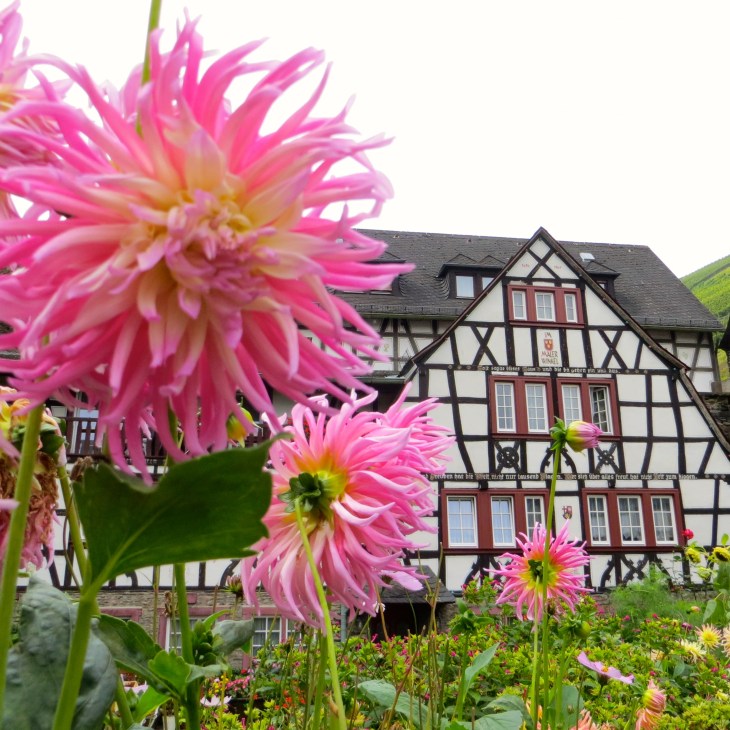
All medieval structures, from the lowliest hut to the grandest palace had one thing in common: building material had to be close at hand. In a rocky area the buildings were stone; and in heavily forested places they used wood for construction. So Europe’s half-timbered houses are concentrated where the thick forests were, at least in the 16th Century. France, Germany, the UK, and Eastern Europe have the largest collections of these lovely tourist magnets.
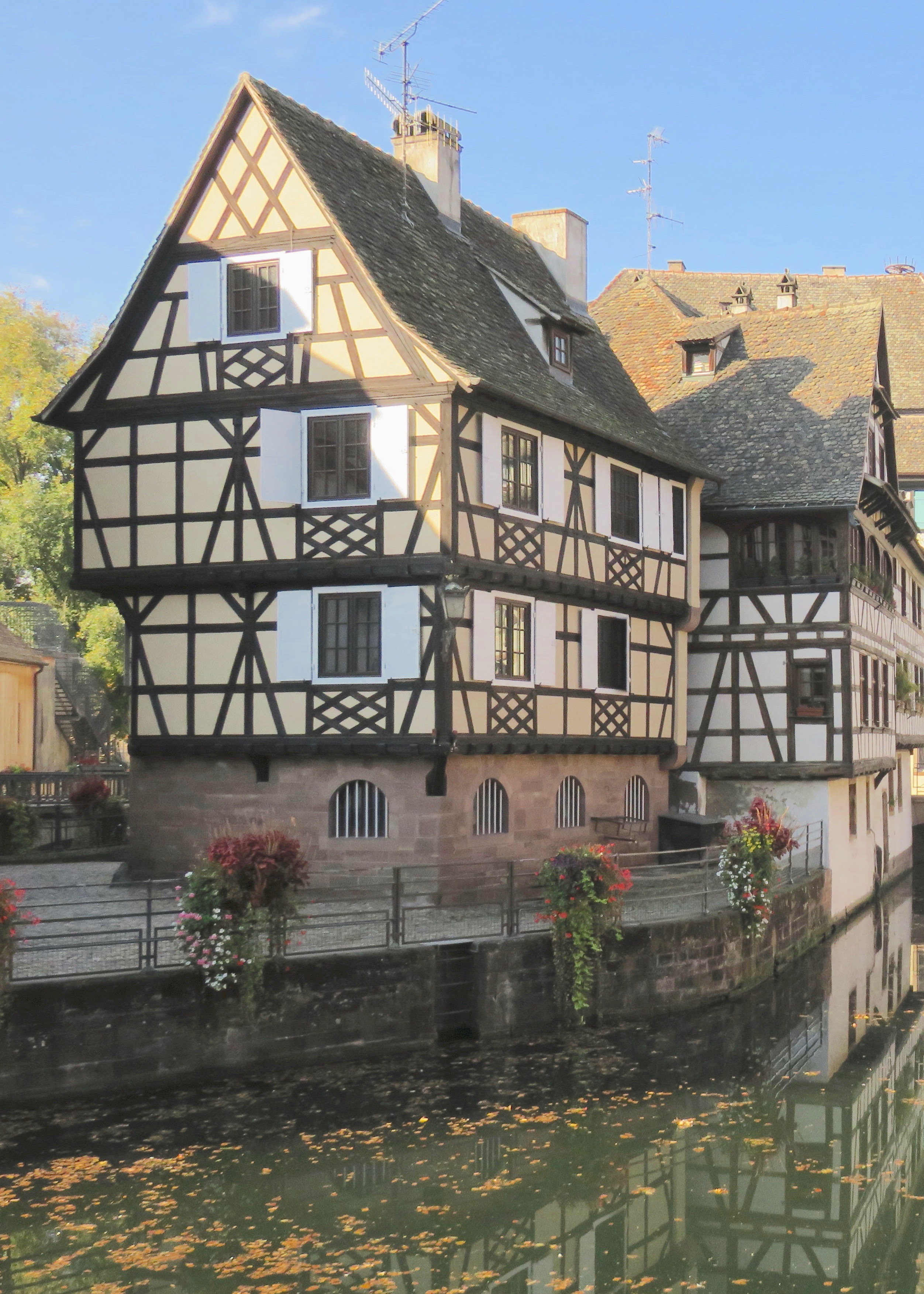
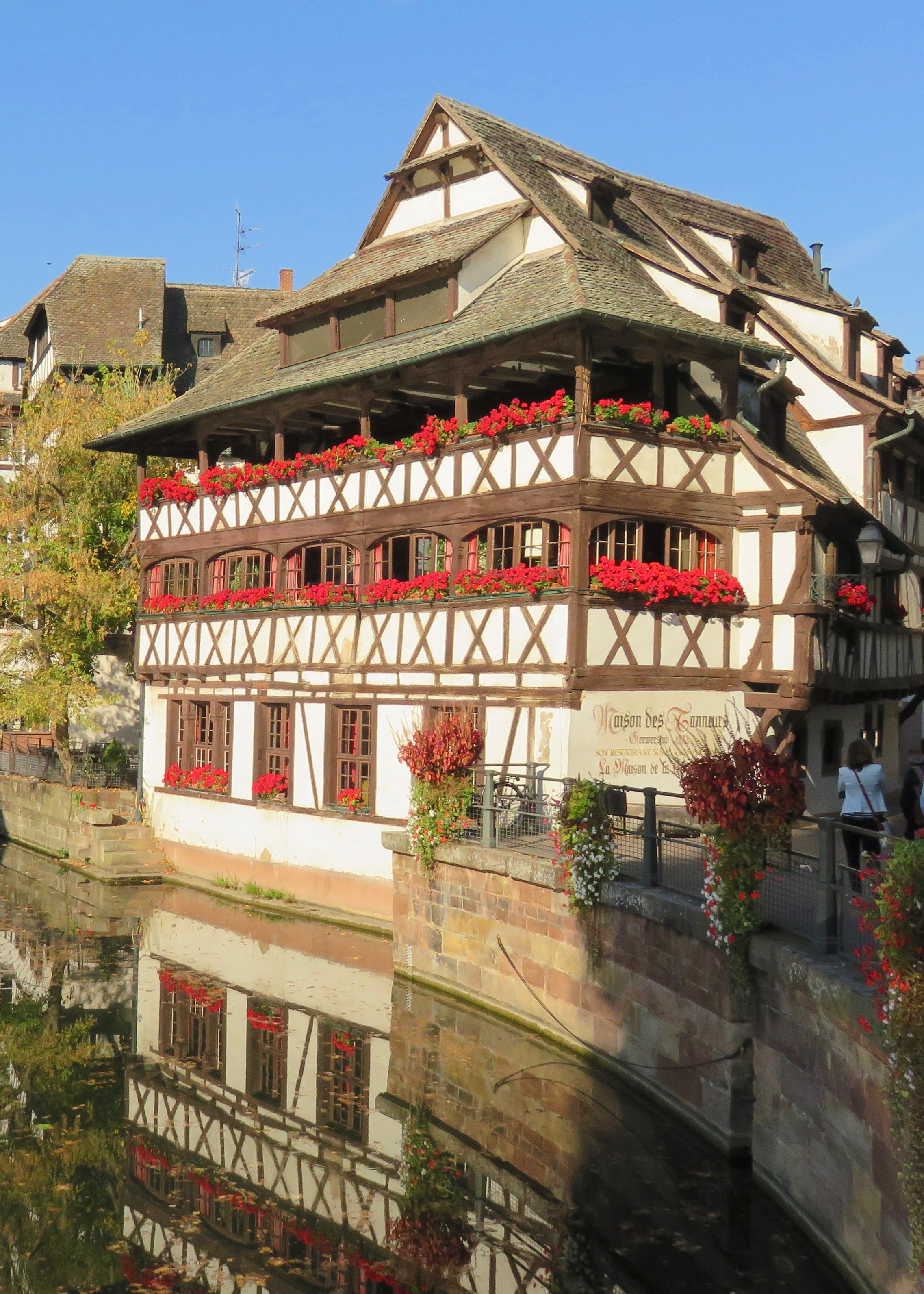
Standard construction rules didn’t exist at the time, so the building process varied from place to place. But each house needed hardwood trees of a similar size, split down the middle and cut into ribs which would be joined with wooden pegs. And if you guessed that each and every step was grueling, backbreaking work, you’d be right.


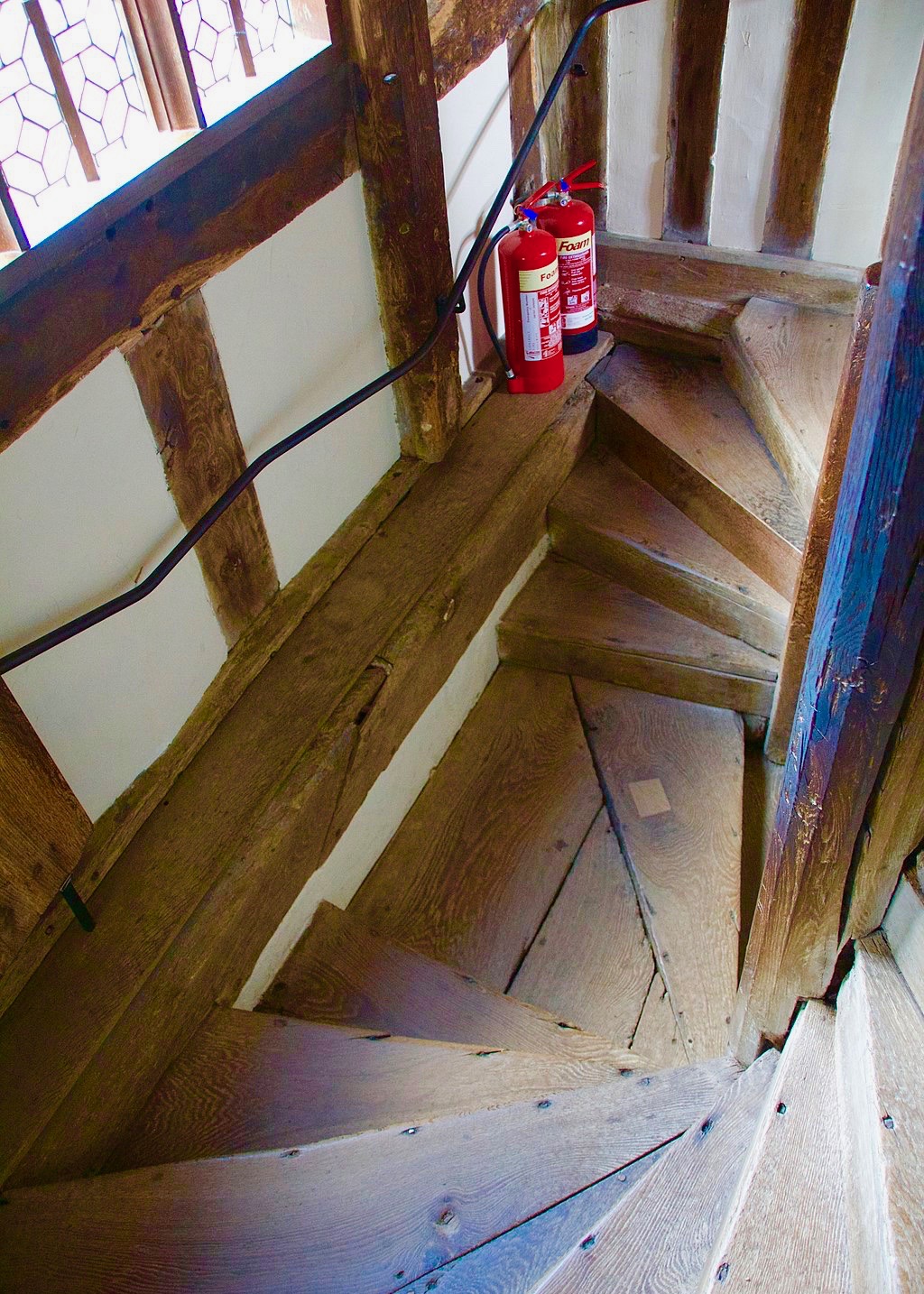
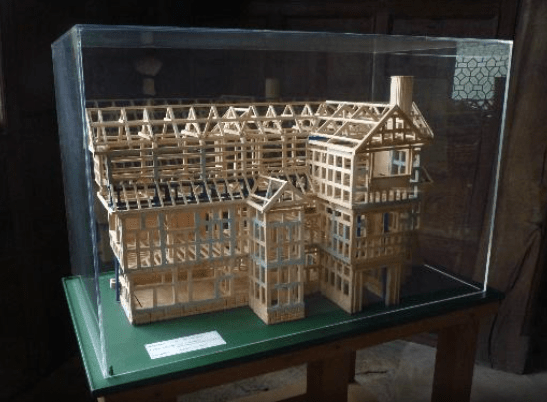
After the split-log frame was built, the spaces between the structural members were filled with bricks, plaster, or wattle and daub, which is a clever concoction of woven twigs and branches that were smeared with clay or mud.
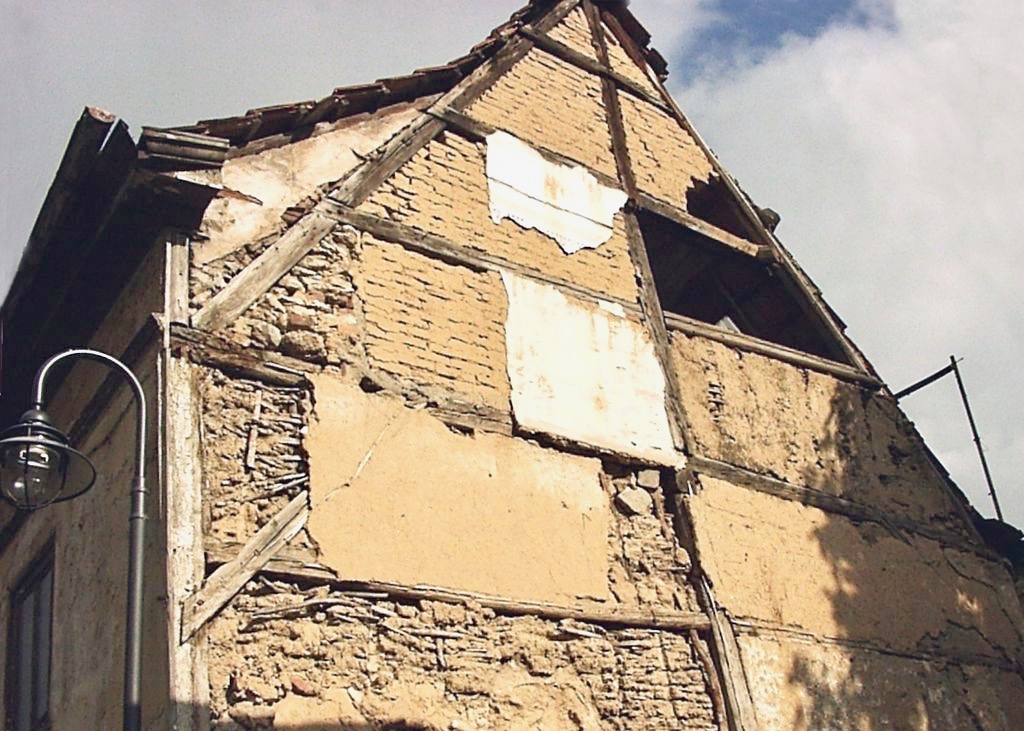
The finished product was a house turned inside out with the skeleton on the outside. In some cases the entire structure was covered with a mixture of plaster and lime, and in others only the panels between the ribs were covered. But tourist villages today want all the medieval charm possible, so they leave the ribs visible and paint the stucco panels a kaleidoscope of colors.
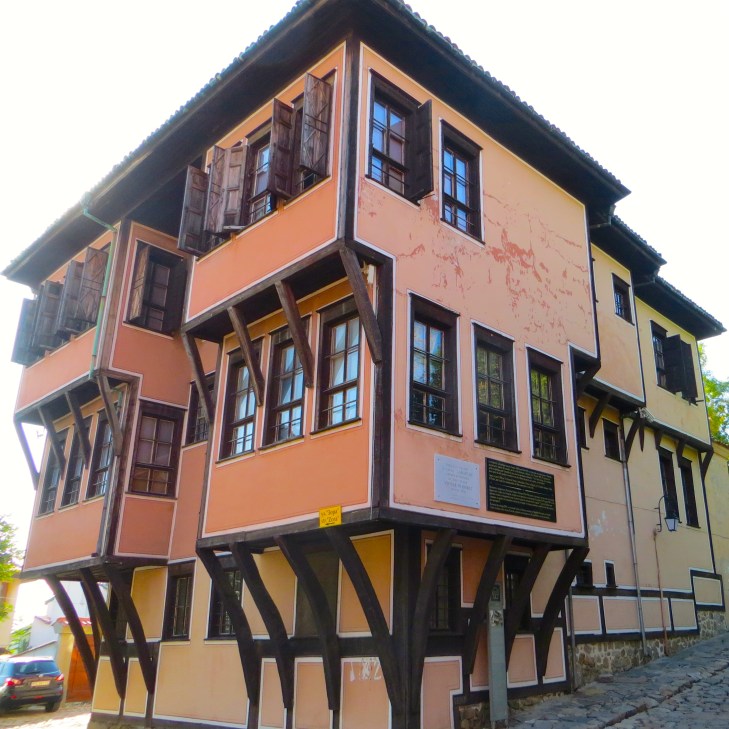
Another common characteristic of half-timbered houses is upper floors which slightly extend out over the lower ones. Opinions differ on the exact function of these cantilevered overhangs. Two obvious advantages are the addition of floor space upstairs, and protection of the lower floor and foundation from the weather. Architects say: “The main advantage, however, is structural: the cantilevers at the ends of the beams partially counterbalance the load carried by their spanning portions.” … Huh?
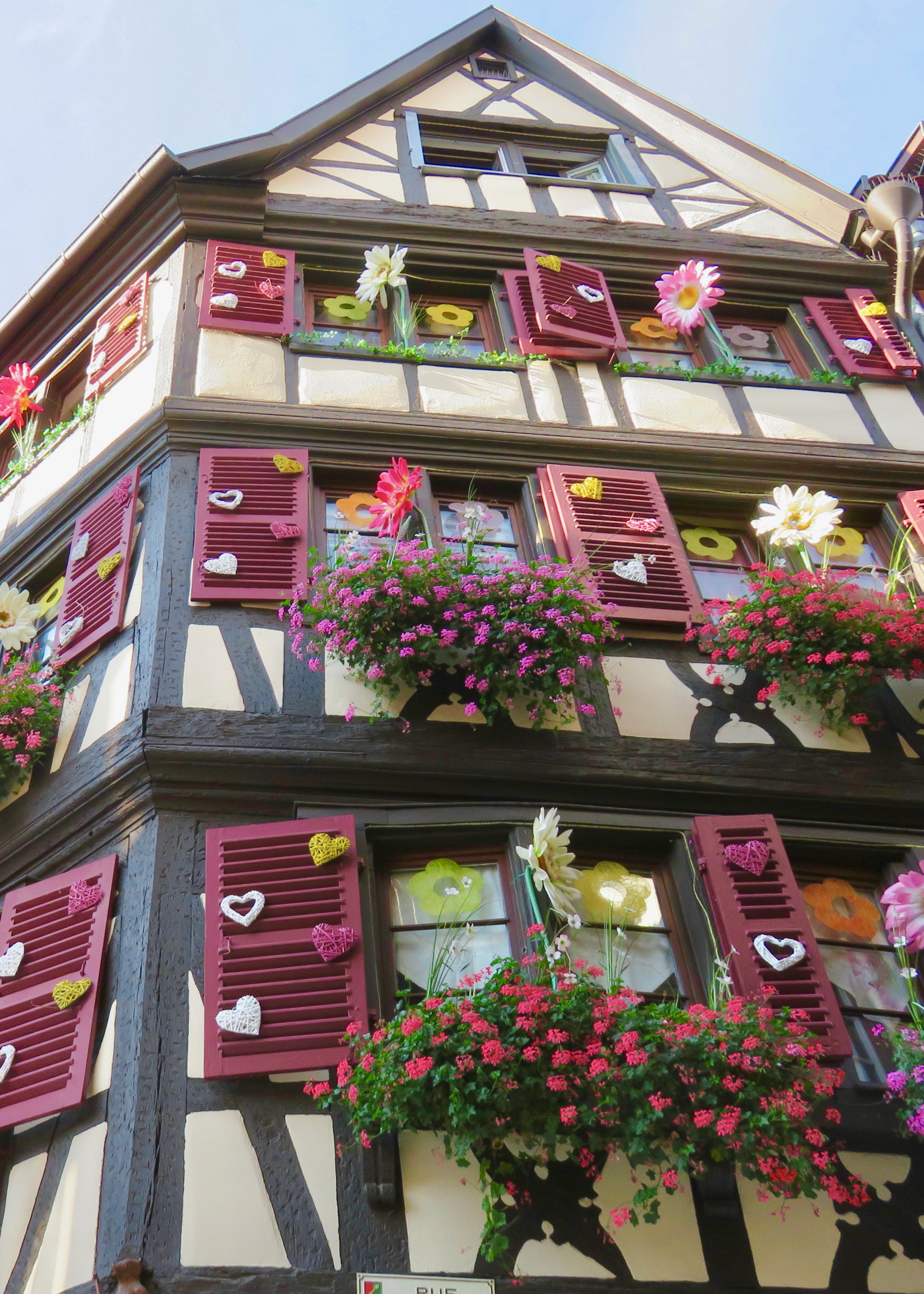
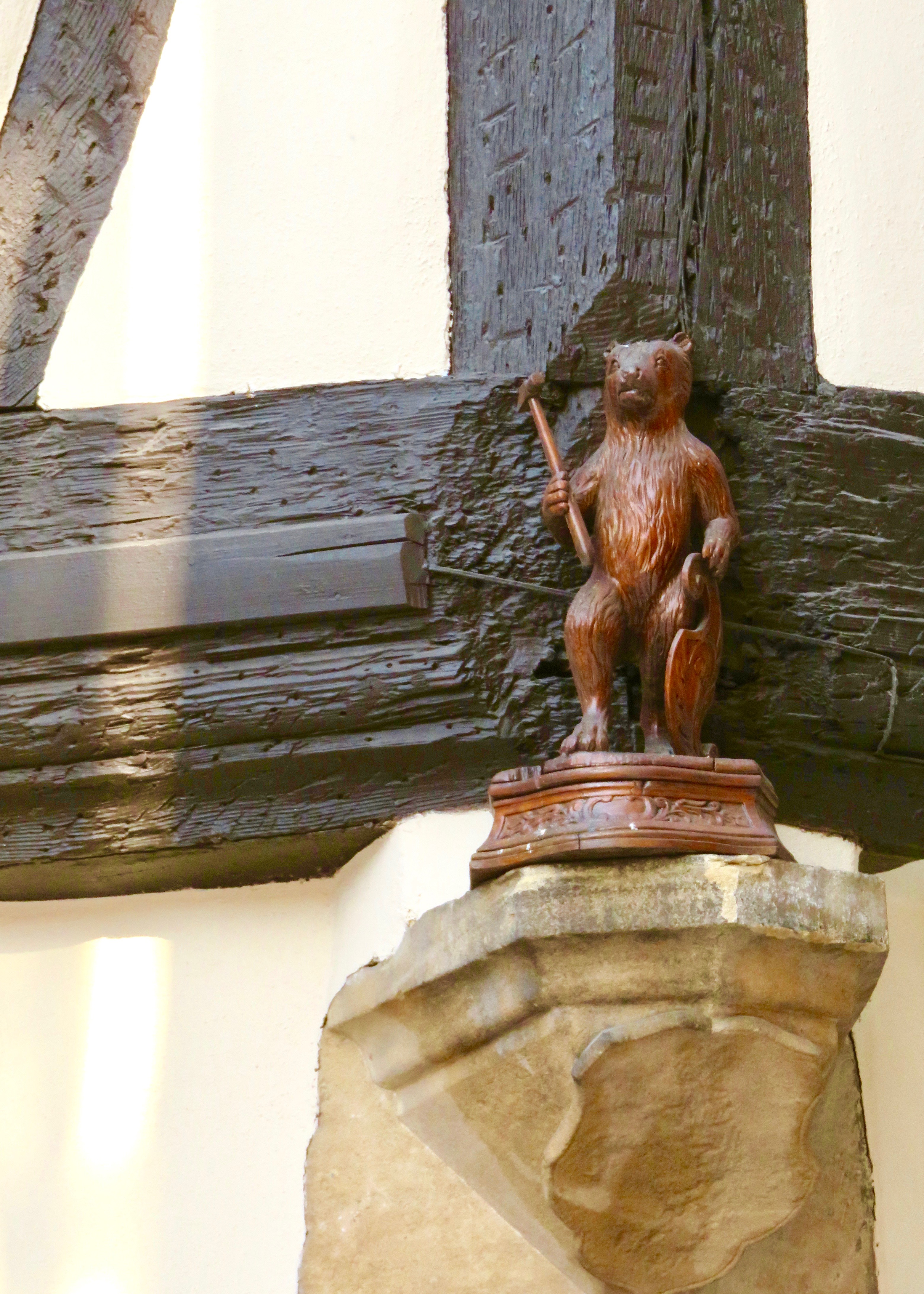
Or as you might expect, even in 16th Century Europe most people wanted to keep the jackals at the tax office at bay. Apparently some cities taxed houses on the width of the street frontage so a narrow house saved the owner money, which could be spent on grog and firewood.
I’ve lived in a few historic houses so I know first hand what ancient plumbing, uneven floors, and hard-to-open doors are like to live with. So I can appreciate the effort that living in a centuries-old house must take. But there’s nothing like strolling a narrow cobblestone street lined with meticulously restored half-timber houses to get a romantic glimpse of the past from another place, another time.
Happy Trails,
James & Terri
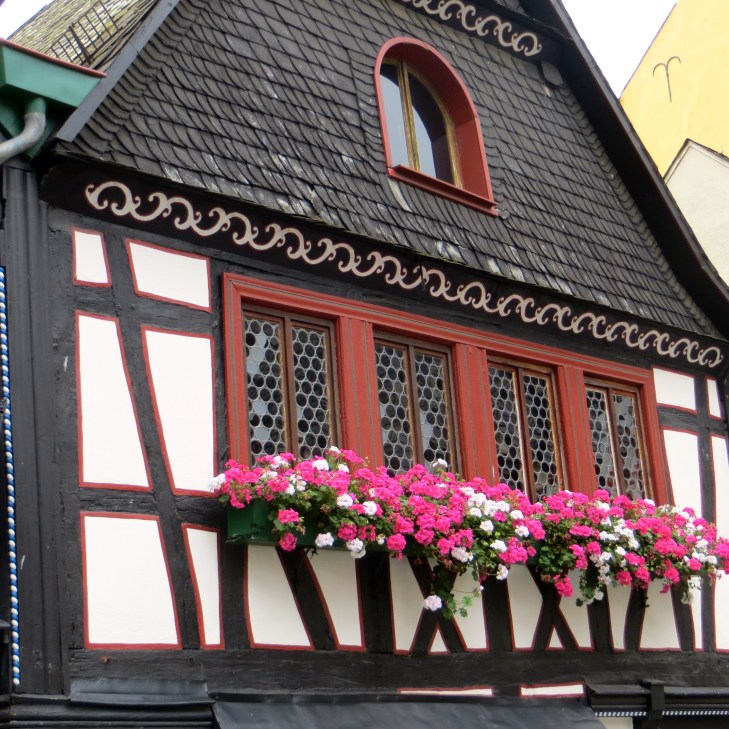
Photo Credits: 6, 7, 8. Mike Peel
I have never known why they were called “half-timbered”. Now another gap in my ignorance has been plastered over!
There must be some exceptional examples to be seen in many parts of Europe.
Yvonne, the definition of half-timbered was new to me as well. Loved the pun BTW. And you’re right about examples all over Europe. Ultimately it came down to places with lots of trees. In our travels we saw the biggest concentration in Germany and Eastern France. Colmar, France had a great collection. ~James
Some great pics. I first saw a lot of half-timbered houses in Chester in England.
Peggy, the West Midlands is one of the areas that’s well known for half-timbered houses. On our last trip to the UK we considered stopping in Chester, but opted for Liverpool instead. Liverpool was fun but sorry we missed Chester. ~James
On one of our first international trips together, we made a reservation at a 13th century half-timbered inn in Salisbury, England. Most of the inn was a modern motel attached to the half-timbered portion, so imagine how thrilled we were to discover we were put in the half-timbered bedroom featured on the inn’s brochure.
Like you, I am aware of the difficulty in maintaining and living in old buildings and am surprised they still survive. I think the oldest one we have encountered on our travels was 12th century.
Ray, I’m sure that staying in the old part of a 13th Century Inn must have been great fun. We lived in the UK for 3 years and traveled around quite a lot, but I don’t think we ever stayed in a half-timbered inn. We toured the Anne of Cleves House Museum in Lewes in the UK, and that was very educational for architecture as well as lifestyle.
One question that came to mind as I wrote this post was don’t they have termites in England? I’ve lived in the deep south of the US for years and termites were a constant struggle. I’ll have to look that one up. ~James
Dear James and Terri;
Thanks for another fascinating post! As an Englishwoman, I have travelled up and down our land a few times; and also much enjoyed the equeally picturesque and sometimes amusing half timbered houses in France and Germany. No – we don’t have termites, unless death watch beetle is the same thing. They, and dry and wet rot are things that eat at the wood in old houses – also rats, if you are unlucky enough to have them. By the way – the Saxons invades these shores circa 500 A.D. – not B.C, which would have been over 2,500 years ago!
Jackie and Graham Usher.(By the way – have you visited Lusignan, France? It’s in our latest post. An amazing royal medieval city…
Another fascina
Jackie, thanks for the AD/BC correction. The Gallivance Editorial Department had the day off. Also, thanks for the termite info. I checked, and the death watch beetle is definitely not a termite. Termites basically look like really big ants and at certain times of the year they have wings for spreading the colony. They can be a menace because their colonies are subterranean and they eat wood inside the wall without the damage showing on the surface. I’m sure that’s more info than you needed but I’ve had some experience with the little buggers and it’s never good news.
I’ll check out your latest post. Thanks. ~James
BTW, I just read your post and made a comment and was denied access. I submitted the form but am not sure it will get through. Just thought you might like to know.
The thought crossed my mind as I read your post as well. I had a cousin in Virginia whose log house had termites [or some such insect] and a friend in Florida whose log cabin was basically destroyed by insects.
Half-timbered indeed. Great photos!
These days the villages that have these wonderful old buildings do everything possible to make them photogenic. I’m not sure they had pink paint in the 16th Century 🙂 . ~James
Thanks for the very interesting post on half timber houses. It always amazes me that homes built so long ago, still stand tall & proud! I have no doubt the maintenance is a bit of a nightmare but I so love that they have been preserved.
Lynn, it is wonderful that these old beauties have been preserved. Of course, I’m sure you have to get permission from the President of the country to tear one of these historic houses down. But in the meantime, they certainly add old-world charm. ~James
I’m with a few others here who were not totally sure of the origin of the term “half-timbered.” I always thought it meant the timbered upper half of a structure since the many Tudor style houses I knew of in my old hometown had stone or brick on the bottom and timbers on the upper floors. This explanation you gave makes a lot more sense!
Lexie, from my reading it was also common to have stone, brick, or stucco on the bottom floor, and apparently the most common motivation was security. There was a solid exterior with one thick oak door, and no windows on the bottom floor to keep out ne’er-do-wells. ~James
So informative- I learned a lot here…and the colourful photos are lovely.
Carol, these brightly colored rows add a Disney-esque factor that I’m sure wasn’t there in the 16th Century, but they make a marvelous display today. ~James
There are some cool half-timbered houses in York, England as well. I just love them. A very informative post. I believe termites like hot weather. We get them here in Spain but not in Canada that I know of.
Darlene, we visited York on our last trip to the UK, and I remember a few of the half-timbered houses. One cool thing about York is that as a historical crossroads, it has it all. Romans, Vikings, and all the English history one would want. It would be a great place to settle in for a couple of weeks. ~James
That is so true. Hubby is from York and we have visited many times. I always find something new to explore. I love all the history.
Gorgeous examples, especially the Little Moreton house!
Rebecca, the Littte Moreton House is one of the largest examples of half-timbering that I’ve seen. Imagine how much effort and materials went into its construction. ~James
Yes, it is very large – 100 trees would you say?
Ohhh? Hard to guess on this one Rebecca.
I never knew what half timber meant,I always thought it was half wood, half something else 🙂 You have a lovely collection of pictures of the pretty homes. Maggie
Maggie, like you I didn’t know what half-timber meant, and if this post has done nothing else it has taught us a useful bit of trivia. I’ve always enjoyed these medieval beauties for their imperfections and sturdy construction. Also, I appreciate that every chink in every piece of wood was made by someone’s hands hundreds of years ago. ~James
Germany was the first European country I visited, and sure enough I saw a lot of half-timbered houses during my stay there. Back in those days, I wasn’t too well-informed about this unique architecture but I loved it when I first saw it. Later on, a question did pop in my head: what does half-timber mean? Apparently this is quite a common confusion as mentioned in some of the comments here. Thanks for explaining about that!
Bama, the half-timber technique spread all over Europe, but it seems like every village we visited in Germany had a few of these sturdy buildings left, particularly the smaller, tourist places. I admire the owners for taking on a restoration because with a wooden structure this old there must be lots of unpleasant, expensive surprises waiting behind those old plaster walls. ~James
Thank you for the architecture lesson and amazing photos, James. These half-timbered homes are super cute, indeed. I’ve definitely seen them in Germany before. And maybe in the UK, too. Unfortunately, none (that I know of) exist in Belgium. Not enough wood, I’m sure!
I never thought about how it would be like to live in these “haphazard” constructions until you mentioned it at the end of the post. Food for thought whenever I spot one again.
Liesbet, if memory serves we saw a few half-timbered houses in Bruges, but the wooden beams seemed to play a secondary role and the rest of the buildings were brick. This ties in with your comment about a shortage of wood in Belgium. I need to go and review my photos.
As for living in old buildings, we’ve lived in a few 100+ year-old houses (which is considered old for the US), and while they have lots of character, you have to pay a price. It seems that these old places are forever moving around a bit- not much but enough to ensure the door or window that opened fine yesterday begins to stick today. Plumbing issues can also be an unpleasant surprise, as well as termites in wooden parts of the building. Having said that, we still love old architecture and live in a historic building, but we’ve become renters instead of owners. It’s wonderful peace of mind knowing that I can just call up the landlord for repairs. ~James
Fascinating background and great photos. We’ve seen a lot of these over the years but I never knew any of the history. In Western Europe a lot of them seem to be tourist attractions but many of the ones we’ve seen in Eastern Europe aren’t quite as well restored (to put it nicely). Thank you for a great post.
Interesting that you mention un-restored houses in Eastern Europe because we’ve experienced the same thing, particularly in places like Bulgaria, and Hungary. We’ve seen some absolutely beautiful old houses that are derelict and slowly falling apart. As old-house buffs it’s sad to see.
We’ve wondered that in ex-Communist countries like these if there are some long-term ownership issues that haven’t been resolved, and consequently, nothing can be done to the property. We’re throwing darts here but the run down places we saw were in bigger cities that obviously have people who can afford to and would want to renovate a beautiful old house that’s in the middle of the city. It’s a conundrum that we don’t understand. ~James
Very cool. I’d be willing to bet, the paint schemes weren’t quite as colorful when they were built. I would not want the job of rehabbing one of those to bring it “up to code”! I like things nice and square and plumb!
Laura, it sounds like you must have dealt with some code enforcement types in the past, because you’re right that restoring one of these would indeed be a nightmare. I can’t imagine the oversight. For a short time in Dallas we lived in one of the few historic neighborhoods there, and I was dumb enough to volunteer to sit on the board. Most of the other board members were absolute Nazis about enforcement, and as soon as I could jump ship I did. ~James
What a beautiful selection, this type of building is just stunning. I love the wonky character of them all, though I can only imagine how expensive they must be to maintain!
Hannah as you know, the UK has lots and lots of dandy half-timbered houses, which was one of the reasons so many of the forests were nearly wiped out and took so long to recover. I love looking at these old beauties but no way would I want to own one. ~James
Well! Apart from learning all about the true meaning of half-timbered, and gaining a better understanding of the construction that underlies all those gorgeous European houses, I found a couple of interesting connections in this post.
First, there was your mention of the cantilevered upper stories. When I read “the cantilevers at the ends of the beams partially counterbalance the load carried by their spanning portions,” I had one of those “Ah, ha!” moments.
For months I’ve been watching a huge highway and bridge construction project; I pass it every day, and sometimes get to sit in stopped traffic and admire it. I’ve not been able to figure out why the beams on which the new six-lane bridge decking rests extend out beyond the decking by several feet on either side. I know pretty much nothing about engineering, I’d bet that those apparently ‘useless’ portions of the beams are involved in counterbalancing the load presented by the bridge decking. If I can find one of the construction crew in an approachable spot, I’m going to ask.
Also, I was fascinated to see the wattle and daub construction. In Louisiana’s Cajun country, that’s called bousillage. The technique is the same, but the materials are different: Spanish moss and mud. I’ve stayed in the oldest building in Breaux Bridge, the old hotel, and it had some cutaway portions of wall that showed the original construction. I’ve got photos and notes scattered all over the place, and have been intending to write about it in the context of a series of Louisiana posts. I’ve just been inspired to do that, and do a little more research, as well. I’d bet anything that the history of bousillage can be traced back to French half-timbered houses.
Linda, your intuition is spot on about “bousillage” originating with French half-timbered houses. I read that in my research on the French vs. German technique. I suspect that all manner of “stuff” was used to infill between the timbers. I also suspect that on the Gulf you’ll find that one of the infills is tabby, which as I’m sure you know is made with oyster shells. And Spanish moss sounds like the perfect infill given it’s availability and light weight. Hopefully they did something to get rid of the chiggers before they stuffed it in the walls 🙂
As for cantilevered extensions, when I think about it they’re essentially flattened Roman arches, which also helped to distribute weight. I have to say that I’m impressed to see when you sit in traffic you’re “using time wisely” as my third grade teacher used to say: thinking critical thoughts instead of just dozing. Let me know what Bubba says about the cantilevers. ~James
Silly me. It wasn’t until last night that I remembered my cousin, who’s a structural engineer. The first thing he pointed out was that the people with my answer probably were drinking coffee in a corner office, rather than populating the job site!
That said (and realizing this is only a tentative explanation, since he’s in Kansas and can’t see the construction), his theory is that the beam extensions are a way of preventing or mitigating road deck damage in case of failure. When a beam like that fails, it does so on a 45 degree angle at the ends. Putting the ends farther out from the roadway means the damage would take place away from the road. There were other things he mentioned, such as the specific size of the beams, but that was so much beyond me I don’t remember most of it. Still, what he said about failure mitigation made sense.
I forgot to add the advice given us kids by my aunt, which later Cajun friends reiterated: to avoid chiggers, never pick up moss that’s been touching the ground. Only pull fresh moss from tree limbs!
Linda, as we southerners have all learned the hard way: never ignore the chiggers. 🙂
Although they look somber and dull (which was more like the saxon way of life), they have passed the test of time and endurance, for sure🙂
Christie, I’m sure that when most of these houses were built it was a big deal to have any color. Probably a whitewash was the best most folks could hope for. I’m sure that a sturdy, dry, and warm house were the top priorities. ~James
For sure, black painted timber and whitewash walls seem to be the custom🙂
I loved this. Fabulous post. So fascinating to learn a bit about these beauties, and the photos are gorgeous. I want to go to Europe right now!
Alison
Alison, most of these photos were taken in a Colmar and Strasbourg, France. If you want to see half-timbered houses these two places fill the bill. Colmar is touristy, but it’s Disney-beautiful. ~James
We stayed a few times in old castles, and appreciated the huge renovations they underwent without impacting the look-and-feel. Those, however, were made predominantly of stone.
How do this timber homes survive centuries of potential fires?
We’ve done a bit of residential renovation which has given us an appreciation for how much time, effort, and money is involved in a historic restoration of any kind. Wood or stone, they all must be labor-intensive, painstaking, and expensive.
As to fire, most of the half-timbered buildings that I’ve seen have been freestanding structures, which must certainly help when it comes to helping stop spreading fires. Also, I’m not sure of this, but I suspect that by the time most of these buildings were built they had figured out fireplaces with properly designed flues for smoke, heat, and safety. Maybe another of the commenters will chime in on this one. ~James
I’ve always loved this construction but didn’t know much about it. Thanks for the explanations and close-up shots. But I’m with you on tolerating old style plumbing, electrical, etc. It’s great to be a tourist and soak up the history, but we live in a pretty modern structure. (Not lavish, but comfortable!)
Amen to a little convenience Rusha. We live in a small rental apartment in our favorite part of town and are happy as clams turning all the repairs and problems over to the landlord. The apartment is old enough to have some character (Mid 1920s), but not so old that it’s a problem. Like you, I love the historical architecture, but when I see me living there it would be nothing but grief. Again, amen to a bit of comfort. ~James
These half timbered houses are so beautiful! We saw them all through Switzerland too 😍. Nice post!
Thanks for the comment Dan and sorry for the delay in response. Sometimes comments just fall through the cracks. I’ve always loved half-timbered construction, and now that I know more about it, I’ll pay more attention on my next trip to Europe (hopefully this fall). ~James
I was just talking to a friend the other day about going to Europe to see these type of houses. They are so beautiful! Thanks for sharing.
Thanks for the comment Anna and for dropping by the blog. Many of these half-timbered houses have been extensively restored, and the tradition is to make the exteriors colorful (and photogenic). If you get a chance make sure to get inside one of these beauties, to fully appreciate the building techniques. ~James